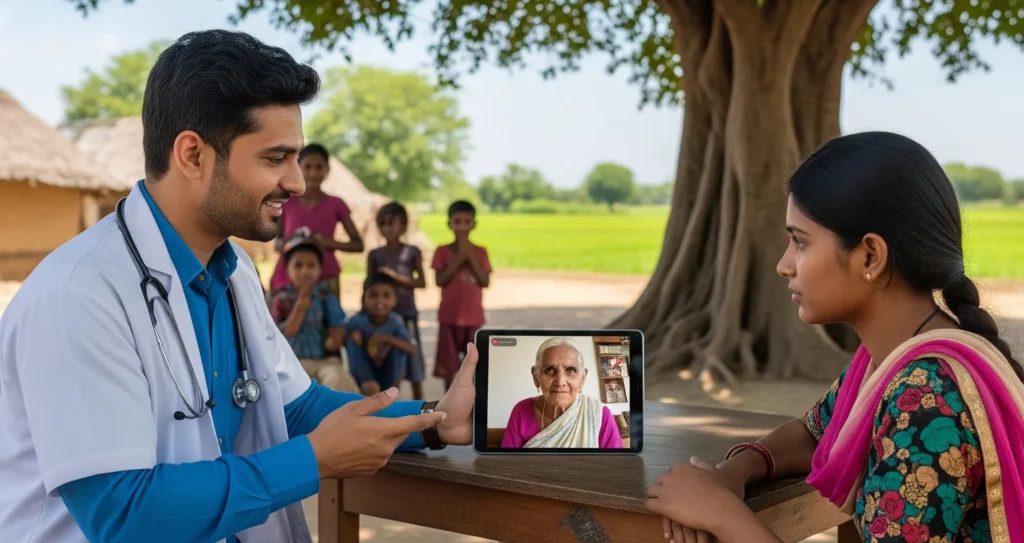Introduction
India’s healthcare system faces a daunting challenge: ensuring equitable access to quality primary healthcare for over 1.4 billion citizens. Despite progress in recent decades, systemic deficiencies persist, especially in rural areas. According to the National Health Profile 2023, India has only 0.7 hospital beds per 1,000 people, far below the WHO benchmark of 3.5.
Primary healthcare—the first point of contact for most citizens—remains under severe stress. With 65% of India’s population in rural regions, the urban-rural divide has produced a two-tiered system where quality care is more privilege than right. This is particularly concerning as India pursues Universal Health Coverage by 2030.
Yet, India’s strengths in digital innovation offer unprecedented opportunities. From AI-powered diagnostics to telemedicine and blockchain health records, technology is emerging as a powerful equalizer in bridging these structural gaps.
Background and Policy Context
India’s primary healthcare crisis stems from decades of underinvestment and fragmented policy execution. The Bhore Committee (1946) laid the foundation, but uneven implementation followed. The National Rural Health Mission (2005), later subsumed into the National Health Mission, expanded rural coverage, yet challenges of capacity, access, and quality remain.
The deficits are stark: India has 1.3 doctors per 1,000 people, compared to the WHO standard of 2.5. Nearly 70% of the population relies on a healthcare system that receives less than 30% of resources. Out-of-pocket expenditure exceeds 60% of total health spending, driving millions into poverty annually.
Policy frameworks like Digital India (2015) and the Ayushman Bharat Digital Mission (ABDM) seek to correct these imbalances by embedding digital infrastructure in healthcare. The IndiaAI Mission underscores the state’s recognition of AI as a strategic enabler. Together, these initiatives represent a governance push to align healthcare with India’s broader digital transformation.
Technology’s Role in Primary Healthcare
AI-Powered Diagnostics
AI tools are reshaping frontline diagnostics. Smartphone-based AI screening for diabetic retinopathy, pioneered by Aravind Eye Care, delivers 95% accuracy without requiring specialist ophthalmologists. Similarly, Microsoft’s Project InnerEye, adapted for Indian conditions, enables TB detection with radiologist-level precision, accelerating treatment in underserved areas.
Telemedicine Platforms
The eSanjeevani platform, launched during COVID-19, has facilitated over 100 million consultations, connecting rural patients with urban doctors. Integrated with ABDM, it strengthens continuity of care within a national digital health ecosystem. Private platforms like Practo and 1mg complement government initiatives, expanding reach across socioeconomic groups.
IoT and Real-Time Monitoring
IoT-enabled devices are creating decentralized monitoring networks. Smart glucometers and blood pressure monitors sync data directly with providers, enabling proactive care. The Swasth Alliance’s maternal health IoT program in rural villages is a notable example, flagging complications before they escalate into emergencies.
Blockchain for Health Records
Blockchain pilots in Telangana and Karnataka demonstrate the potential of tamper-proof, portable health records. Such systems reduce redundancy, improve interoperability, and strengthen patient trust by safeguarding sensitive data.
Vision AI: Governance and Policy Insights
Vision AI positions itself as a unique bridge between technological innovation and healthcare governance, offering aspirants a structured approach to understanding systemic transformation.
- Policy Research and Analysis: A dedicated research wing produces evidence-based briefs and state-level implementation studies, equipping aspirants with real-world insights beyond textbooks.
- Case Study Repository: A curated database of Indian and global best practices, from Tamil Nadu’s digital health records to Odisha’s mobile health units, enriches exam preparation with authentic examples.
- Ethics and Governance Integration: Specialized modules train aspirants on digital ethics, data privacy, and equitable access—critical competencies for future administrators.
- Industry Partnerships: Collaborations with NGS , and private innovators provide aspirants exposure to live policy environments and frontline implementation challenges.
Challenges and Ethical Considerations
Technology’s promise is tempered by ground realities.
- Digital Divide: Only 43% of rural primary health centers have reliable internet access, limiting digital adoption.
- Data Security: The absence of a sector-specific health data protection law risks undermining trust.
- Algorithmic Bias: AI-driven tools could entrench inequalities if trained on non-representative datasets.
- Digital Exclusion: Elderly, disabled, and economically vulnerable groups risk marginalization if solutions are not inclusive by design.
- Cost and Sustainability: High upfront investment in infrastructure and training requires strong political and fiscal commitment.
Conclusion
Integrating technology into India’s primary healthcare system is not just a digital upgrade—it is a systemic reimagining of delivery models. AI, telemedicine, IoT, and blockchain hold the potential to bridge long-standing inequities, but their success hinges on governance, ethics, and inclusivity.
Institutions like Vision AI can play a pivotal role by preparing civil servants to think critically at the intersection of technology and public health. India’s healthcare transformation will ultimately be judged not by the sophistication of its tools but by its ability to deliver accessible, affordable, and equitable care to every citizen.
If executed with foresight, India’s digital health journey could become a global model of technology-driven inclusive development.

